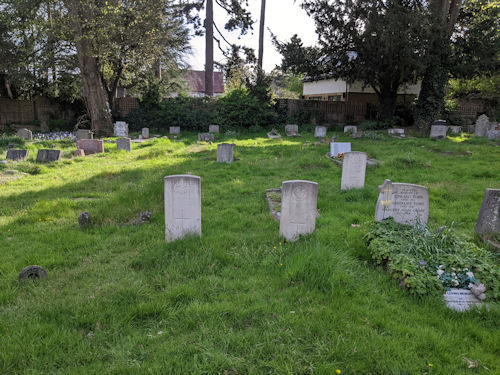Name
Herbert Bertram Mason
Conflict
First World War
Date of Death / Age
14/05/1917
25
Rank, Service Number & Service Details
Gunner
76560
Royal Garrison Artillery
140th Siege Battery
Awards: Service Medals/Honour Awards
British War and Victory medals
Cemetery/Memorial: Name/Reference/Country
RICKMANSWORTH (CHORLEYWOOD ROAD) CEMETERY
D. 6. 27.
United Kingdom
Headstone Inscription
Not Researched
UK & Other Memorials
Croxley Green Village Memorial, Croxley Green,
All Saints' Church Shrine, Croxley Green,
Rickmansworth Urban District Memorial,
St. Michael’s Church Memorial, Chenies, Bucks.
Pre War
Herbert was 25 when he died and the husband of Annie Mason, 14 Scots Hill, Croxley Green.
When he enlisted he gave his address as near the Post Office, Scots Hill and his occupation as a farm labourer. He was born in 1891 in Amersham. Herbert married Annie (nee Gilbey) in the last quarter of 1911. Annie was 28 in 1911, and a factory paper sorter living with her parents at 4 Cherry Tree Cottages, Croxley Green. Herbert’s parents were John and Charlotte Mason of Old House Farm, Amersham Common, Chenies Parish. In 1911 John was a farm labourer but he died before Herbert enlisted in 1915. Herbert had five older siblings, three brothers and two sisters.
The Watford Observer of 23 June 1917 refers to him as a resident of Croxley Green. He enlisted in Watford.
Wartime Service
Herbert was attested for Short Service in the Army on the 25th November 1915, a scheme under which a man could serve for three years or the duration of the war, whichever was the longer. He was placed on the Army Reserve list the following day but was not mobilised for service until the 25th April 1916, when he became part of the Royal Garrison Artillery with the rank of Gunner.
He was 24 years-old when he enlisted and was a large man, standing at 5’11”. His trade as a Farm Labourer, would have ensured he had a reasonable physique and was fit for the role as a soldier.
A period of intense training now commenced, during which Herbert would have been trained in the use of the weapons of the used by the Siege Batteries of the Royal Garrison Artillery. These were usually the 6 inch, 8 inch and 9.2 inch heavy howitzers, whose purpose was to send large calibre high explosive shells in high trajectory, known as plunging fire. As British artillery tactics developed, the Siege Batteries were most often employed in destroying or neutralising the enemy artillery, as well as putting destructive fire down on strongpoints, dumps, store, roads and railways behind enemy lines. Herbert received additional training as a Layer. Gun laying means moving the axis of the bore of the barrel in two planes, horizontal and vertical. A gun is "traversed" – rotated in a horizontal plane – to align it with the target, and "elevated" – moved in the vertical plane – to range it to the target.
Following the completion of his training he Joined the 140th Siege Battery on the 30th May 1916. Two months later, on the 26th July 1916, as the Battle of the Somme raged, Herbert Mason filled in his Army Will in which he left all his worldly possessions to his wife, Annie. The 140th Siege Battery was posted to France on the 1st August 1916 armed with four 6" Howitzers. It joined 15th Heavy Artillery Group (HAG) on the 7th August 1916 and transferred to 36th HAG on the 10th September 1916 serving under it until 21st March 1917. Unfortunately, the war diary for 140th Siege Battery cannot not be traced, but it is known that the Battery served along the Western Front throughput the great war.
Herbert was wounded on the 8th April 1917, most probably in the opening phase of the Battle of Arras, suffering injuries to his Face and Left Arm.
He was initially taken to No.3 Australian Field Ambulance, but was later moved to No.5 General Hospital at Rouen. His injuries were serious enough for him to be evacuated to the UK and he left France aboard the Hospital Ship “St. George” on the 19th April 1917. He was transported to the Military Hospital in Grove Road, Richmond, Surrey, which was part of the Union Workhouse infirmary and had opened in August 1915. Among its patients were German Prisoners of War. Herbert Mason died at the hospital on the 14th May 1917, as a consequence of his injuries and septicaemia and he is buried in the Chorleywood Road Cemetery, Rickmansworth, Hertfordshire.
Additional Information
Annie Mason was awarded a pension of 13s 9d from 19 November 1917.
Acknowledgments
Malcolm Lennox, Tanya Britton, Brian Thomson, Croxley Green in the First World War, Rickmansworth Historical Society 2014, Paul Johnson



